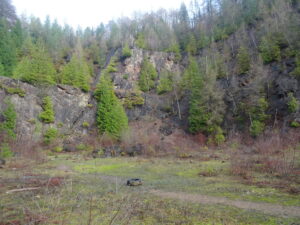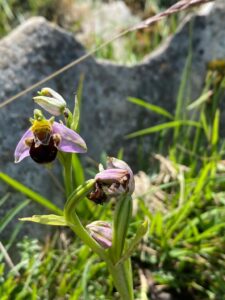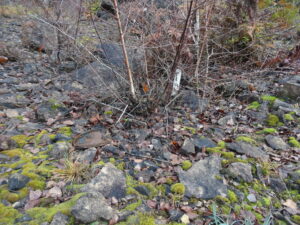In 2023, Sue Brooks found orchids in unlikely places.

On June 28th, I read in The Guardian Country Diary about finding bee orchids among the litter on the edge of a Business Park in Sandy, Bedfordshire — they are notoriously fickle and seldom appear in the same spot twice.
My own experience exactly. I haven’t seen any in the Forest of Dean for years. But there was something about that particular Diary that opened a window in my imagination. I knew where to go, and that I MUST go — on that day. I could see myself walking there. I said it out loud. SHAKEMANTLE QUARRY, and felt the shivers going down the back of my neck. No one knows the origin of the name.
This is what I do know: ironstone was mined there until the 1860s and then it was quarried for limestone until 1960. It is occasionally used by climbers in the summer when the weather is good, and all the year round for flytipping.
What follows is based on my own diary.
The great walls rear up, dark and fissured. Horizontals and diagonals and everywhere the green uprising of spruce and birch. Twenty or thirty feet from tiny cracks in the rock and spreading out over the quarry floor. Along the horizon, the trees march to the edge; a dense semicircle of darker green. A red kite passes.

I look carefully at the plants that thrive there — barren strawberry, sedge, medick, but surprisingly no brambles. How would orchids grow when there is no soil to speak of, even for brambles…? Suddenly, a touch of pink. A tiny centaury plant with a single flower, and close by, something else. A bee orchid. I got down on my knees. Yes — there were two faded, aphid-ravaged orchid flowers on a short stem. THRILLING. I stayed at orchid level and cast my eyes, and there were more — and more. Some with blackened stems, the flowers eaten off by deer perhaps, and all past their peak. Under a birch sapling I found one magnificent plant that had grown to its full splendour — ten inches on a vivid green stem with SIX flower spikes. The top three were perfect. Three delicate lilac petals above the bee itself, presented like a jewel on a velvet cloth. So beautiful and at the same time, comical. The absurdity of it made me laugh. A clown’s face and plump body wearing pantaloons, arms akimbo and mouth wide open in rude delight. Apparently, the bee orchid is self-pollinating. It doesn’t need to attract a bee; the pollinia dangling so enticingly over the clown can do it on their own. The rest is circus. Simply for the pleasure.
Much, much pleasure. After those first ecstatic moments, I covered the ground in Shakemantle, and found bee orchids everywhere. Beside the flytipping, under the odd birch sapling, in the middle of deer droppings and in the rockiest places where barren strawberries put out their single fruit. Fifty plants, or even more.
I knew the quarry is a favoured spot for peregrines, and began to realise two had been calling the whole time without my noticing. I sat down to watch where they were flying around their nesting place on one of the ledges and then began to feel my presence as an intrusion. Time to be on my way rejoicing.
Thank you Country Diary (Derek Neimann).
Postcript: I returned on December 6th to see if there was enough light for a couple of photos. Grey and sour-smelling after all the rain. Remarkably clear of debris — no rusting fridges and bits of car engines. I found the spot where I saw the first half-eaten orchid, so have included that.

Of course I will return on June 28th 2024, just in case.